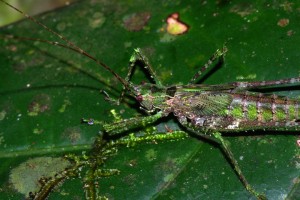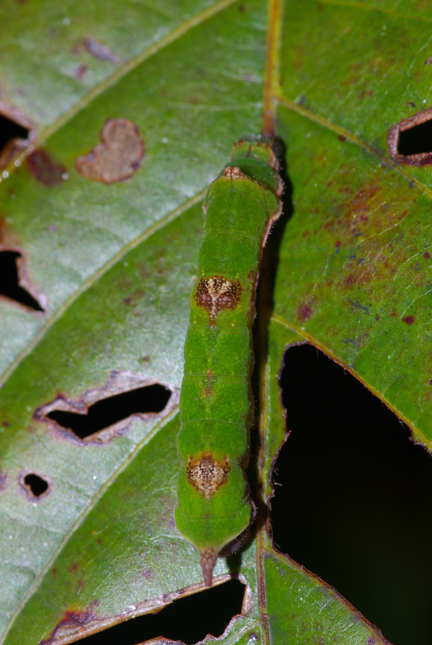 I’m walking down one of the narrower trails at the La Selva Biological Station, in Costa Rica. On either side of the trail there is a literal wall of vegetation, a range of greens going from the pale lime tones of fresh leaves on the tips of shrubs, through the pea-shaded smooth leaves of vines and their paler tendrils that curl relentlessly on anything they touch; to the jades and olives and emeralds of older leaves, mosses, grasses and even swaths of bark. Within this riotous vegetation, a comparable—if not larger—palette of browns cover the gamut from the deep dark tones of wet soil, through the umber tones of rotting leaves, the hazel shades of different barks, the whimsical corky wings of vines thick as a baby’s arm, to
I’m walking down one of the narrower trails at the La Selva Biological Station, in Costa Rica. On either side of the trail there is a literal wall of vegetation, a range of greens going from the pale lime tones of fresh leaves on the tips of shrubs, through the pea-shaded smooth leaves of vines and their paler tendrils that curl relentlessly on anything they touch; to the jades and olives and emeralds of older leaves, mosses, grasses and even swaths of bark. Within this riotous vegetation, a comparable—if not larger—palette of browns cover the gamut from the deep dark tones of wet soil, through the umber tones of rotting leaves, the hazel shades of different barks, the whimsical corky wings of vines thick as a baby’s arm, to  the fawnish tones of fallen leaves, carrying with them the brighter tones of yellows, oranges and reds. Through gaps in this wall, a dark, dripping and richly scented forest
the fawnish tones of fallen leaves, carrying with them the brighter tones of yellows, oranges and reds. Through gaps in this wall, a dark, dripping and richly scented forest
beckons, a place to get lost easily, ensnared in its incredible biological wealth.
Within this extraordinary setting flowers unfurl like gaudily lit ornaments, reflecting all shades of red, yellow, blue, purple and white, loudly making their silent calls to the insects and animals that will get attracted to them and which, in the process of getting a reward of nectar or pollen or both, pollinate them. On top of leaves, creatures sit still, camouflaged, cryptic and even invisible, as if waiting for something to happen: a mate to find them; a predator to avoid; a food source to exploit; a moment to hatch or a violent instant to die. Everywhere you observe closely, you find evidence of one of two processes: eating or reproduction. Out here in the forest is all about food and sex.
On top of a mossy leaf, a slight discontinuity calls my attention. It is barely perceptible, almost like a bump on the leaf. Upon close inspection, a fairly large immature katydid sits motionless on the leaf, legs stretched behind it, antenna twice as long as its two-inch body lying like hairs along the leaf’s central vein. The patterns in its developing body (still showing wing buds, tiny facsimiles of the adult wings that will soon develop) matches with uncanny perfection the patterns of the leaf it sits on, mossy, licheny, irregular, but so exactly matched. I aim my camera and flash at it, struggling to find it in the viewfinder and worse, focus on it, and then, after the explosion of light, an interesting phenomenon reveals itself. Lit by the light produced by the flash, the katydid is quite obvious and differently colored than the leaf it rests on. So much that I do a double take from the camera’s screen to the leaf and back again thinking I managed to photograph a separate katydid than the one I was aiming to. The camera’s flash reveals a brightness, a reflectance, and even shades of color not evident under the natural light of the forest. The katydid is invisible only under the organic, green-tinted light of this special place in the forest. Any other place, under any other kind of light, the insect would be evident, glaring even, exposed and, thus, prey. Eaten. Dead.
Another leaf, another bump. This time, a caterpillar lies motionless along the mid-rib of a green and brown pockmarked leaf. The caterpillar blends in by matching color, tone, shape and even the brown spots seen in the surrounding leaf. How long did it take it to find this perfect match? How does it know it has achieved a perfect blend? The questions emerge unfiltered, anthropomorphic at times, unsolvable except by the universal rules of nature. Given the forest dweller’s remarkable abilities to blend in, to be concealed, inconspicuous and veiled produced by the shaping forces of natural selection, how do creatures find themselves to mate, to prey upon, to avoid being preyed upon, and to reproduce?
The forest is in constant motion, all its inhabitants, plant and animal, engaged in a seemingly random symphony of action, orchestrated in shifts, diurnal, nocturnal, crepuscular, summer, fall, winter; with defined and often reversed roles of predator, prey, mate, contender, challenger, enemy, sibling, parasite, scavenger; all species with special tools to survive, even thrive, within incredibly tight energy budgets, where mistakes are paid in blood, lymph, or sap; where success is measured in nutrients, nectar, pollen, flesh, tissue, or simply by the ability to survive and live another day. Creatures intersect each other’s lives and feed or hide, crawl under or fly through, capture or avoid, copulate or perish unfertilized, bursting with the primal instinct of being. The rich budget of the forest and its teeming diversity appears to endure, in spite of all the lives seemingly cut short, the eggs that don’t hatch or get eaten; the larvae that fail to pupate, gets parasitized or feeds a bird’s nestlings; the seed that gets consumed before it germinates; the sapling that starves before it reaches the life-giving sun; the tree that falls and brings down with it an entire living ecosystem, now lost and rotting in the soaked horizontality of the forest floor. Every demise engenders life and directs back into the system energy and nutrients. The symphony of life prevails.
The characters of the forest find each other by their sheer numbers, by their highly developed senses, by their specializations and their adaptations, by their synchronicity and their timing, by sight, and sound, and smell, in a bewildering sensory range that spans the sub-levels to the ultra-levels. We wander through this rich landscape with our own limited sensory range, like half-blinded explorers, seeing a lot but missing most of it. So, one answer to the initial question is, slow down and smell, touch, hear and see, taste and feel the forest around you. Eventually, if you wait long enough, you’ll find each other.
Carlos de la Rosa

Recent Comments